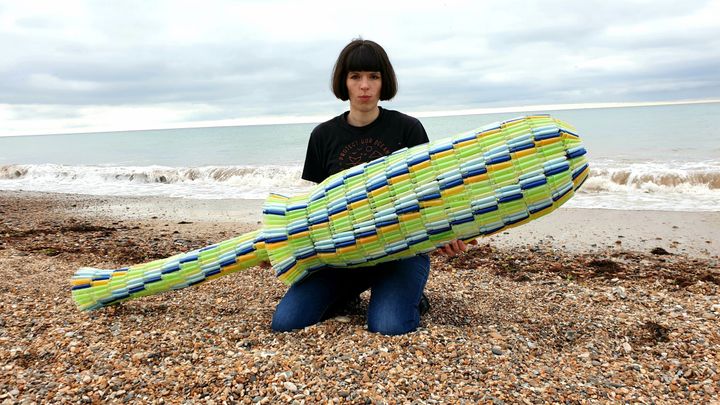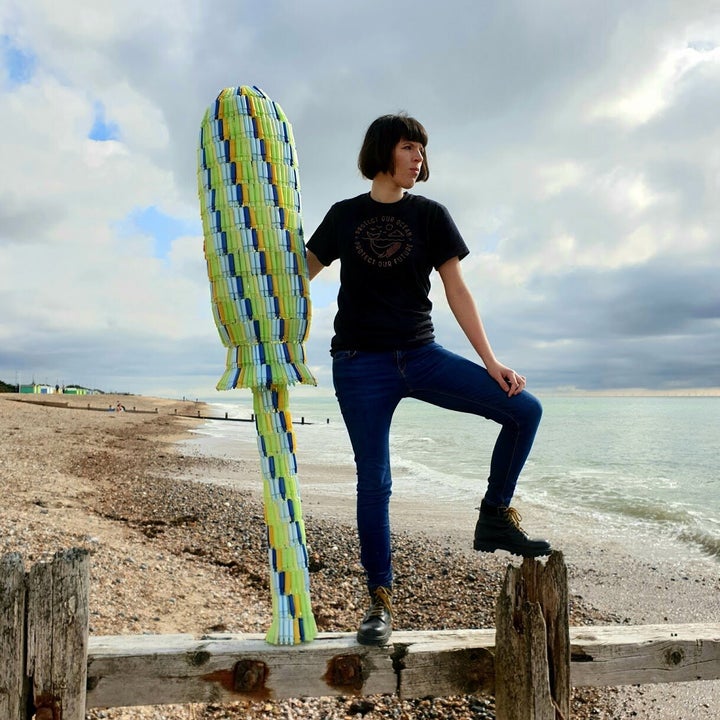
An environmental campaigner has created a giant, plastic tampon – made from other people’s abandoned tampon applicators.
Ella Daish, the founder of the #EndPeriodPlastic campaign, asked people to send her any plastic tampon applicators they found polluting their local environment, beach, or waterway. She ended up with more than 1,000 items, which she then used to create the 6ft sculpture.
“I instructed people to take precautions when picking these up, not only due to the pandemic, but also because of where tampon applicators come from,” Daish reassures HuffPost UK. “People rinsed them off and upon receiving them I washed and disinfected the applicators – it was certainly a unique activity!”
Daish’s ongoing campaign urges brands and retailers to remove plastic from their period products. She’s already convinced Aldi, Sainsbury’s, and Superdrug to ditch plastic applicators for biodegradable, cardboard alternatives in their own-brand products.
Now, she’s got her sights set on the queen of period products: Tampax.
“Manufacturers like Tampax often put the blame on consumers to avoid
ownership of the problem, but they must be held accountable,” she says.
“As a manufacturer, they have got the resources and money to bring about change at source, this is exactly what needs to happen, to put a stop to the negative impacts downstream.”

The giant, plastic tampon is designed to get Tampax’s attention. Of the applicators Daish was sent, 87.5% of them were Tampax. The remaining 12.5% were a mixture of other brands and ones which could not be identified.
“I was able to identify which manufacturers the plastic tampon applicators came from by looking at their different colours, shapes and patterns,” she explains. “It’s really easy to do and some even come with branded symbols on them, such as Tampax’s Pearl range.”
The finished tampon is made exclusively from 1,200 Tampax applicators collected from 15 locations across the UK.
“I expected a lot would be found, so when boxes and boxes arrived full to the brim with applicators, I wasn’t surprised,” says Daish. “However, I was shocked by the high number of applicators coming from specific locations, such as the River Clyde.”
The project, which Daish began this summer, has been months in the making and creating the final structure wasn’t easy.
“The applicators were attached to an underlying wire structure, there was no adhesive or plastic used in the process,” she explains. “It took a few months for all the plastic tampon applicators to arrive and for me to clean them, but the process of planning and constructing the giant applicator took about a month.”
Daish’s online petition calling for an end to unnecessary plastic in period products has already gained more than 237,000 signatures. She’s also written an open letter to Tampax, which has been supported and signed by a coalition of over 40 groups, politicians and activists, including Caroline Lucas, Gillian Burke, Julia Bradbury and Megan McCubbin.
HuffPost UK asked Procter & Gamble, the makers of Tampax, if they have plans to change their products.
In response, the brand issued a statement saying it “agrees that plastics do not belong on beaches”, which is why it reminds customers how to dispose tampons and applicators properly on its packages.
Tampax also said it is working towards reducing its material usage and incorporating 50% sustainable materials in its products. The statement pointed out that Tampax already offers some alternative options, including tampons with cardboard applicators.
“As a brand, we remain committed to finding solutions where people with periods don’t have to compromise quality, while also having the absolute least impact on the earth,” the statement said. “But solutions are not straightforward, take time and we need to balance the needs of the people who use our products while striving to find alternatives.”